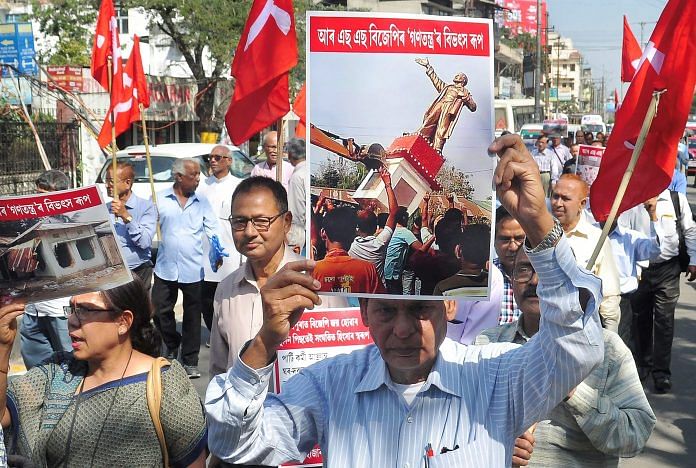A word of advice to friends in the Left movement, or whatever is left of it. The Communist party in Russia is looking for non-Communist icons to rebuild the country.
The demolition of Lenin’s statue in Tripura has set off a series of similar incidents in some parts of the country. Statues of local social reformers and icons patronised by political parties have been vandalised.
Though this is not the first time that statues are being brought down, forcibly removed or desecrated, the post-poll situation and the total rout of the Left in Tripura infuse the episodes with a greater sensitivity.
For the Left, left with no political, social or ideological relevance, the felling of Lenin’s statue has come as an opportunity to hit the headlines.
The entire Left cadre, nearly all 400 of them, were out on the streets of Lutyens’ Delhi, beating their breast for the ‘fall of Lenin’, animated more by the episode than the fall of their government in Tripura.
Prime Minister Narendra Modi, BJP president Amit Shah and home minister Rajnath Singh have condemned the incidents. The home minister has called for strict vigil, and strong action against the people indulging in such lawlessness. Yet the Left seems to be in a mood to make the most of the situation.
A word of advice to friends in the Left movement, or whatever is left of it. The Communist party in Russia is looking for non-Communist icons to rebuild Russia. During the USSR days, 7 November was a public holiday and a day of celebration to commemorate the 1917 October Revolution. Not anymore. In today’s Russia, it is just another ordinary working day, and 4 November, designated the ‘national unity day, has been declared a public holiday.
Vladimir Putin’s Russia has no love lost for the 1917 revolution, which is portrayed as nothing more than a ‘political tool’ used to come to power and commit atrocities and ‘brutally intervene in the private lives of the people’. As the atrocities of the Lenin-Stalin era are out in the public, it is becoming increasingly difficult to bring the events of 1917 into the narrative of Russian glory.
When tyranny ruled
Speaking on the 100th anniversary of the 1917 revolution, Putin said, “When we look at the lessons from a century ago, we see how ambiguous the results were, and how there were both negative and positive consequences of those events. We have to ask the question: was it really not possible to develop not through revolution, but through evolution, without destroying statehood and mercilessly ruining the fate of millions, but through gradual, step-by-step progress?”
All that we know about Lenin, Stalin and China’s Mao Tse-tung are from the so-called historical accounts heaped on us by multitudes of sham historians, self-proclaimed liberals, spineless intellectuals, armchair social reformers and opportunistic Marxists stuck in last century’s dogma.
For them, their god could have done no wrong, did no wrong, and continues to live and inspire the non-existent proletariats.
Recent archival discoveries in Russia have unearthed the purges, mass killing of ‘deviationists’ within his own party, public lynching of prospective contenders for power after labelling them “bloodsuckers” and “enemies of the people”, and much more that defined Lenin’s tyrannical reign of six years or so.
Joseph Stalin knew of Lenin’s weakness, exploited it to his best advantage, but kept the lie about his invincibility alive in order to perpetuate his own image. Nevertheless, Stalin’s brutalities, whatever little is known about them through information available in hitherto hidden archives, will make Lenin appear Gandhian in comparison.
Shattered perceptions
The KGB-built false image of Lenin was demolished by Russian film-maker Alexander Sokurov through his film Taurus. The 2001 biographical film, one of the entries at the 2001 Cannes festival, portrays Vladimir Lenin in his true colours. Discarding the deified image of Lenin, the film depicts his weaknesses and shortcomings, as well as his utterly disgusting side.
The erstwhile CPI(M) government in West Bengal and its entire leadership pleaded with their Russian masters, with folded hands, not to release the film in India, dismissing it in two words: “CIA propaganda”. They knew their own cadre would demolish Lenin’s statues in their backyards if they got to know the real Lenin.
The collective memory of the Russians has long rejected Lenin and Stalin, moved away from the USSR, and forgotten the tyranny as a bad dream. Russians who lost family members in the purges, lynchings, torture and live skinning conducted on the orders of Lenin were among the ‘hooligans’ who demolished Lenin statues in the erstwhile USSR.
There is no place for Lenin in the new Russia. Can there be any place for Lenin in a new Tripura?
A different question:
However, the statue-felling incident should prompt us to look at a broader picture and ponder over the obsession of political parties and followers of social icons to inundate streets and mohallas with statues of their idols.
It would be worth recalling Robert Browning’s poem ‘The Patriot, wherein he wrote: “It was roses, roses, all the way,… Thus I entered, and thus I go.”
‘The Patriot’ is about how the mightiest of icons fall after a period of heady popularity. The very same people who worshipped you yesterday will be there cheering your execution tomorrow.
Political fortunes can change, and a robust democracy is all about constant change. People are increasingly beginning to vote for development and corruption-free governance rather than dogmatic ideologies. Can Parliament and the state Assemblies debate this issue and come up with a statute on statues?
The author is a security and strategic affairs commentator and former editor of ‘Organiser’.






